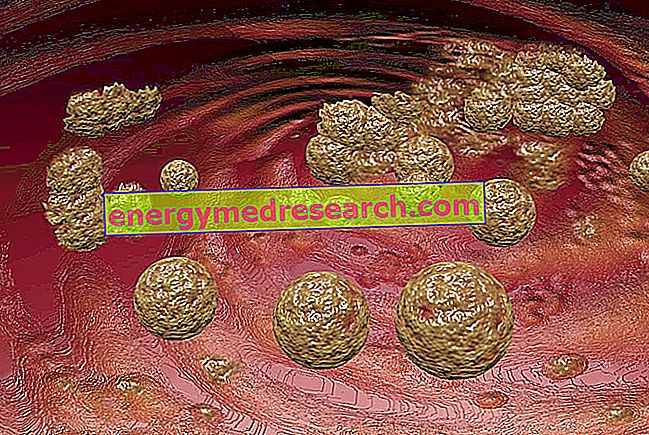Anti-snoring plasters

An excellent remedy against snoring, the nasal plasters were born to interrupt that vicious circle of oral breathing (therefore of roncopatie) during night rest.
How they are made?
The nasal plasters consist of two strips of semi-rigid plastic material: the flexibility of these elastic bands promotes the expansion of the nasal passages, a particularly useful effect in the case of a "stuffy nose". To facilitate adherence to the wings of the nose, the two semi-rigid strips are held together by a special hypoallergenic adhesive.

Nasal plasters can be defined as a sort of "allarganaso" instrument - which is the only one available on the Italian market - able to promote breathing by expanding the wings of the nose.
Sports pads
The same nasal plasters used to improve sleep quality can also be used by athletes during a sports test.
The principle of action is always the same: by dilating the nasal passages and favoring breathing, the nasal plasters can reduce the sense of fatigue because they can increase the flow of air during the race.
Please note
However, this should not cause misunderstandings: the nasal pads do not improve the performance of the athlete in any way. Although athletes who wear these nasal patches claim to "breathe more easily", this feeling is completely subjective. Moreover, more than the amount of air reaching the pulmonary alveoli, the main limiting factor in athletic performance seems to be the body's ability to extract more oxygen from the inspired air.
How to use
The use of nasal plasters is extremely simple. Before using them, proper face cleaning is recommended to promote adhesion of the adhesive to the nose. For the same reason, the use of face creams for the night is not recommended, as they may reduce their adherence.
In the presence of oily skin, before sticking the patch on the nose, it is recommended to use a specific detergent for this type of skin.
Next, remove the oiled film that protects the adhesive and make the plaster adhere perfectly to the wings of the nose (at the root). To fix the patch, press the sides of the device lightly with the help of your fingers.
When you wake up, to make it easier to remove, simply moisten the patch with a little warm water and gently tear it up by lifting the adhesive from the fins.
In the case in which, after the removal of the plaster, the skin of the nose appears slightly reddened, red or dry, it is recommended to apply a specific cream to soothe, de-reddening or nourish the skin.
Types of nasal plasters
The nasal plasters are not all the same: each type of plasters has been specifically designed according to the age of the patient, the problem for which it is used and the type of skin for which it is intended.
The list includes:
- Nasal patches for children and adults (eg RespiraBene for children 5-12 years and Respirabene grande, for adults)
- Balsamic or normal cerottini (ex. RespiraBalsamic balsamic for adults)
- Plasters for sensitive skin and normal skin (ex. RespiraBene for sensitive skin)
Contraindications
Nasal plasters are not effective for all types of snoring or stuffy nose: when the breathing difficulty is linked to anatomical problems such as deviation of the nasal septum, these medical devices are completely ineffective. Similarly, the cerottini do not bring beneficial to the chronic forms of roncopatia associated to phenomena of transient interruption of the breath (or, more simply, sleep apnea) during sleep.
In addition to the cases just described, the use of nasal plasters is ineffective or contraindicated in all those pseudo-pathological forms in which the inevitable snoring can only be corrected through minimally invasive surgery. For this purpose, nasal plasters should not be used in the following cases:
- Nasal polyposis
- Tonsillar / adenoid hypertrophy
- Breathing difficulties caused by obesity
The use of classic nasal plasters is contraindicated in subjects allergic to latex: the product casing contains natural rubber latex which could induce allergic reactions, even serious ones, in sensitive patients.
Warnings
To take full advantage of the product's effectiveness, it is necessary to pay attention to the correct use. First of all, the nasal plasters are disposable, so they must be thrown away after use (do not use the nasal patch for more than 12 hours a day).
The nasal plasters are not all the same; therefore, it is advisable to prefer those appropriate to the size of one's nose. For this reason, smaller nasal plasters are available for children, and larger nasal patches for adults.
Nasal patches should not be applied to wounds, burns and irritations.
Before use, it is recommended to carefully read the package insert contained in the package.
Advantages
Nasal plasters are very beneficial for those suffering from snoring. Let's see why:
- They are very simple to use medical devices
- The cost is easily amortized
- They are practical (disposable)
- Ensure immediate relief from the stuffy nose
- They do not contain drugs
- They reduce snoring problems even in patients with allergies
- Gently dilate the nasal nostrils by relieving the feeling of a stuffy nose
- They adapt perfectly to the nose thanks to their anatomical shape
- When applied correctly, the plasters do not come off at night
- They are readily available in pharmacies and parapharmacies
Disadvantages
This type of cerottini can do nothing before a nasal pathology: these instruments are not able to "heal" snoring because their action is exercised exclusively at the level of the first part of the upper respiratory tract. Nasal patches can therefore improve the quality of sleep by promoting nasal breathing, but without acting in any way on the cause causing snoring.



